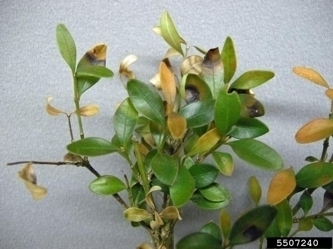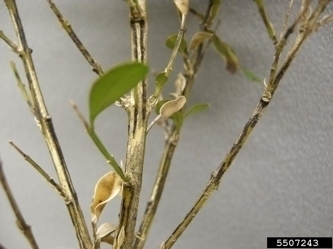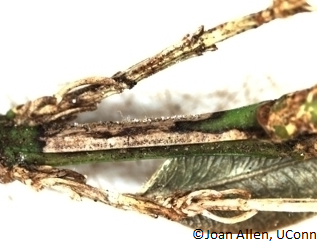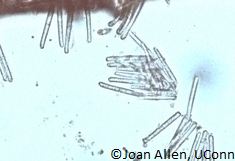Calonectria pseudonaviculata (syn. Cylindrocladium buxicola and Cylindrocladium pseudonaviculatum)
Boxwood blight is a serious disease of boxwood. It was first confirmed in the United States in 2011 in North Carolina and Connecticut and has since spread to many eastern states and others in the Midwest and Pacific Northwest. The disease is considered widespread in Europe. Rapid defoliation under favorable environmental conditions destroys the aesthetic value of the plants. If you believe your plants may be infected with boxwood blight, an accurate laboratory diagnosis is recommended to prevent spread through recommended management practices.

Hosts
Boxwood (Buxus species), Pachysandra and Sarcococca (sweet box) are currently known to be hosts of this disease. All are in the Buxaceae family. Susceptibility varies among boxwood species and cultivars but none are completely resistant. Buxus sempervirens ‘Suffruticosa’ (English boxwood) and B. sempervirens ‘American’ are especially susceptible.
Symptoms
Symptoms occur on leaves and stems. Brown spots appear on leaves following infection and after the spots enlarge and coalesce, leaves drop. As the spots enlarge, concentric lines of darker and lighter shades of brown may develop. Infected leaves range in color from tan to bronze. Black streaks or lesions occur on infected stems from the top to the soil line. Root infection does not occur. The most striking symptom is extensive defoliation. Favorable conditions are temperatures of 64-80°F and high humidity. Symptoms can be similar to those of other boxwood problems including Volutella blight, root rot, boxwood leafminer and winter injury. Volutella may occur on the same plant with the boxwood blight pathogen.



Disease Cycle
Under ideal conditions (warm and humid), the fungus will produce spores on the undersides of infected leaves and in stem lesions in as short a time as one week after infection. Spore masses are white and under magnification have a crystalline or quartz-like appearance. The spores are quite sticky and easily adhere to people, animals, insects or tools that come into contact with them, allowing them to be spread easily to new plants and infection sites. Additional spread occurs via splashing water or wind-driven rain. Long distance spread is via human movement of infected plant material. The fungus can survive in plant debris or in the soil during the winter and in the absence of a host plant for at least 5-6 years.

Sporulation

Cylindrocladium pseudonaviculatum
Control Measures
The primary control measures for boxwood blight fall under the category of sanitation and include:
- Plant only disease free new boxwood and other host plants.
- Purchase plants free of any symptoms including leaf spots or stem lesions.
- When introducing new boxwood into a landscape with established host plants, quarantine the new plant(s) away from the others for at least one month to observe for symptom development prior to planting if possible.
- If symptoms are noticed, have the plant(s) checked at the UConn Plant Diagnostic Laboratory
- If boxwood blight is confirmed, removal of the plant(s) with symptoms and those within 10 feet of those is recommended. The safest approach is to remove all boxwood/hosts from the property. Plants should be double bagged and placed in the trash or buried two feet deep. Do not compost.
- Replant with non-host plants.
Protective fungicides can be used to prevent infection in remaining plants, especially when the conditions favorable for infection are expected. Active ingredients registered for use by home gardeners include chlorothalonil and mancozeb. Thorough coverage is essential and this is a challenge on boxwood due to its compact growth habit so spray until runoff.
Despite good cultural practices, pests and diseases at times may appear. Chemical control should be used only after all other methods have failed.
For pesticide information or other questions please call toll free: 877-486-6271.
UConn Home and Garden Education Center, 2019/